
Test of Quantum Electro Dynamics in He and H2
The theory of Quantum Electro Dynamics (QED) represents the most fundamental description of all phenomena in electromagnetism. The theory goes beyond the description of Dirac in relativistic quantum mechanics as described by the
Dirac equation. The theory is inspired from experiments that show devations from the Dirac description, most notable in experiments on the
Lamb shift and the g-2 factor of the electron. For the first experimental determinations of these phenomena the Nobel Prize in physics (1955) was awarded to Willis Lamb and Polykarp Kusch. Later another typical QED phenomenon was predicted by the Dutch physicist
Hendrik Casimir, later known as the
Casimir effect.
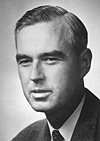
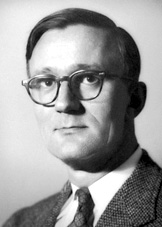
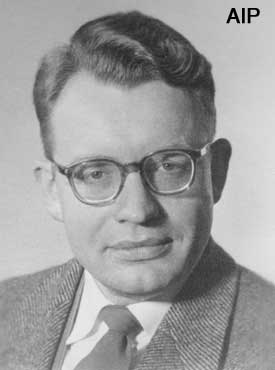
Willis Lamb Polykarp Kusch Hendrik Casimir
Phenomena not accounted for in the Dirac formalism are the self-energy of the electron and vacuum polarization.
For the theoretical description of QED the Nobel Prize (1965) was awarded to Sin-Itiro Tomonaga, Julian Schwinger, and Richard Feynman, who independently formulated the theory in rather different mathematical frameworks. Later Freeman Dyson showed that the theoretical descriptions were equivalent.
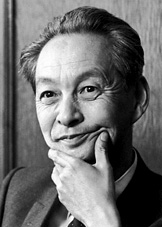
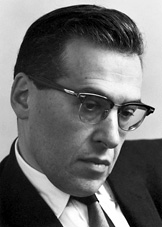
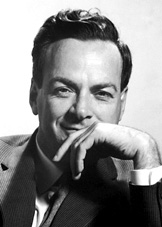
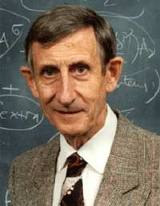
Sin-Itiro Tomonaga Julian Schwinger Richard Feynman Freeman Dyson
QED tests in the Helium atom
Currently the theory of Quantum Electro Dynamics is the most accurately tested theory in physics. While the Lamb shift was originally determined from the spectrum of the hydrogen atom, calculations of atomic QED-phenomena can also be tested in two-electron systems, like the helium atom. This gives also the opportunity to test two-electron contributions in QED. The status of atomic physics theory has evolved such that solution to the non-relativistic Schrodinger equation can be solved to 20-digit accuracy, even for the two-electron system He. Hence spectroscopic measurements present direct tests of relativistic and QED phenomena. The Lamb shift in helium is by far the largest in the ground state, where the effects of the sefl-energy of the electron and the vacuum polarization are strongest.
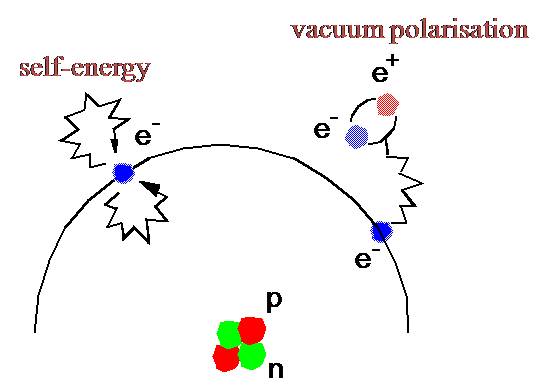
QED-effects in the helium atom
The QED-effects in the helium ground state were tested in a series of experiments, employed with a wavelength tunable extreme ultraviolet (XUV) laser source.
 A measurement with an XUV laser source based on fifth-harmonic generation of the doubled output of a commercial pulsed dye laser, delivering pulsed radiation at 58 nm to excite the 1s-2p transition in helium. A value of the Lam shift was determined with an accuracy of 1000 MHz. The work was published in Physical Review Letters: First laser excitation of the 4He 1 1S - 2 1P resonance line at 58 nm.
A measurement with an XUV laser source based on fifth-harmonic generation of the doubled output of a commercial pulsed dye laser, delivering pulsed radiation at 58 nm to excite the 1s-2p transition in helium. A value of the Lam shift was determined with an accuracy of 1000 MHz. The work was published in Physical Review Letters: First laser excitation of the 4He 1 1S - 2 1P resonance line at 58 nm.
 For the generation of XUV laser radiation the commercial PDL is replaces by a travelling-wave pulsed-dye amplifier (PDA), which is injection seeded by a continuous-wave ring dye laser. The experiment on the 1s-2p transition in helium and a derivation of the Lamb shift has an accuracy of 45 MHz. The work was published in Physical Review A: Lamb shift measurement in the 1 1S ground state of helium.
For the generation of XUV laser radiation the commercial PDL is replaces by a travelling-wave pulsed-dye amplifier (PDA), which is injection seeded by a continuous-wave ring dye laser. The experiment on the 1s-2p transition in helium and a derivation of the Lamb shift has an accuracy of 45 MHz. The work was published in Physical Review A: Lamb shift measurement in the 1 1S ground state of helium.

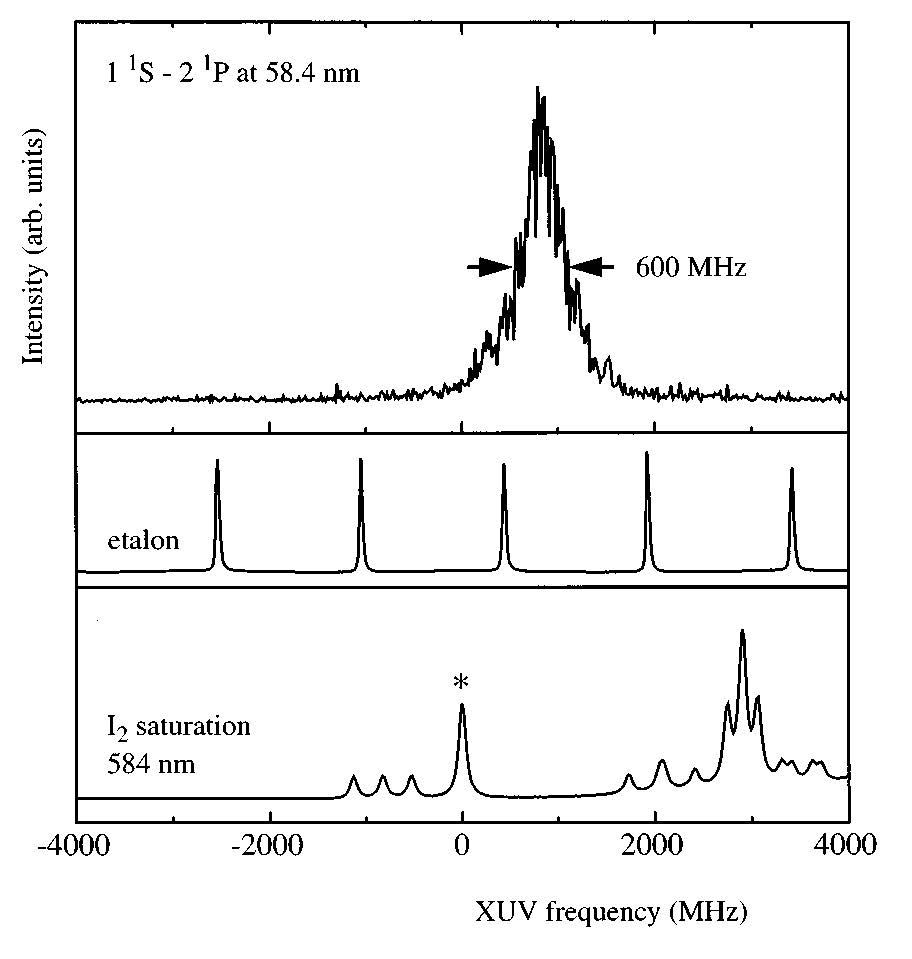
Resulting spectra obtained from XUV-PDL source (left) and XUV-PDA source (right)
 Later, almost two decades after the first experiments on the He Lamb shift, an XUV frequency comb laser system was developed in our Amsterdam team to excite the 1s-5p transition in helium at 51 nm. This led to a derivation of the Lamb shift at an accuracy of 6 MHz. The work was published in Physical Review Letters: XUV frequency comb metrology.
Later, almost two decades after the first experiments on the He Lamb shift, an XUV frequency comb laser system was developed in our Amsterdam team to excite the 1s-5p transition in helium at 51 nm. This led to a derivation of the Lamb shift at an accuracy of 6 MHz. The work was published in Physical Review Letters: XUV frequency comb metrology.
QED tests in the Hydrogen molecule: measurement of dissociation energy
Quantum ab initio calculations have progressed since the original calculations by Heitler and London, that currently calculations of the Born-Oppenheimer energies, adiabatic and non-adiabatic corrections are so accurate that QED effects (including high-order relativistic effects) can be derived from spectroscopic measurements. One such experiment is the measurement of the dissociation energy of the Hydrogen molecule. In fact experimentally the Ionization Potential of H2
was determined in a three independent experiments bridging part of the energy separation between the molecular ground state and the extrapolation to the ground stae of the H2+ ion.
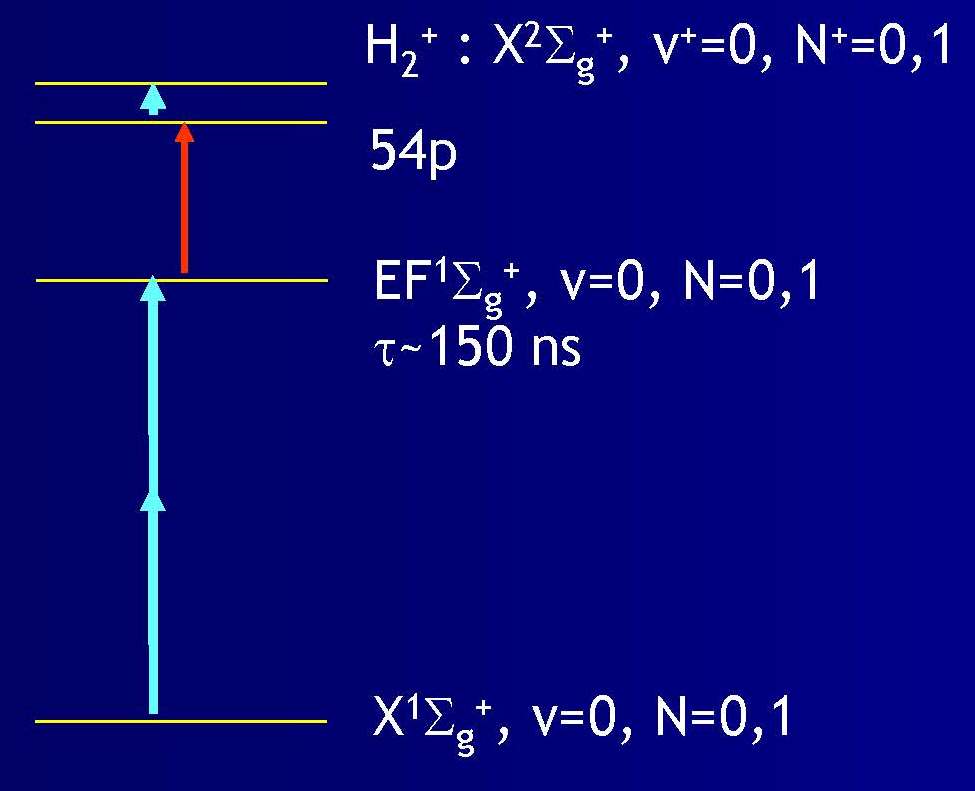
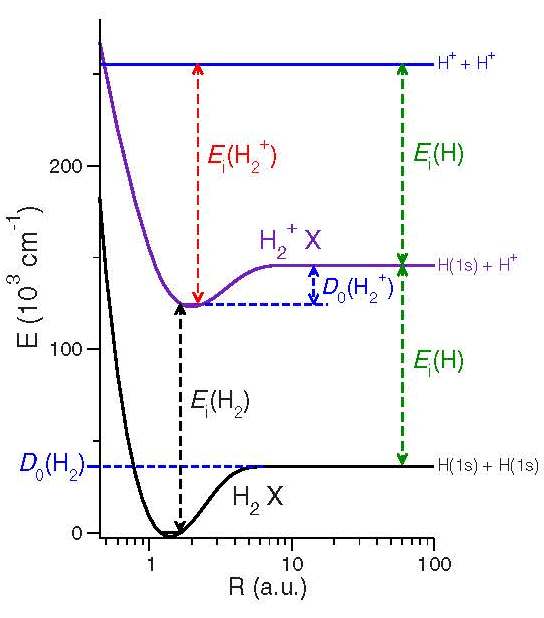
Left: 3 step excitation Right: relation between IP-limit and dissociation
For these studies a Titanium-Sapphire Oscillator amplifier laser system was used, built at LaserLaB.
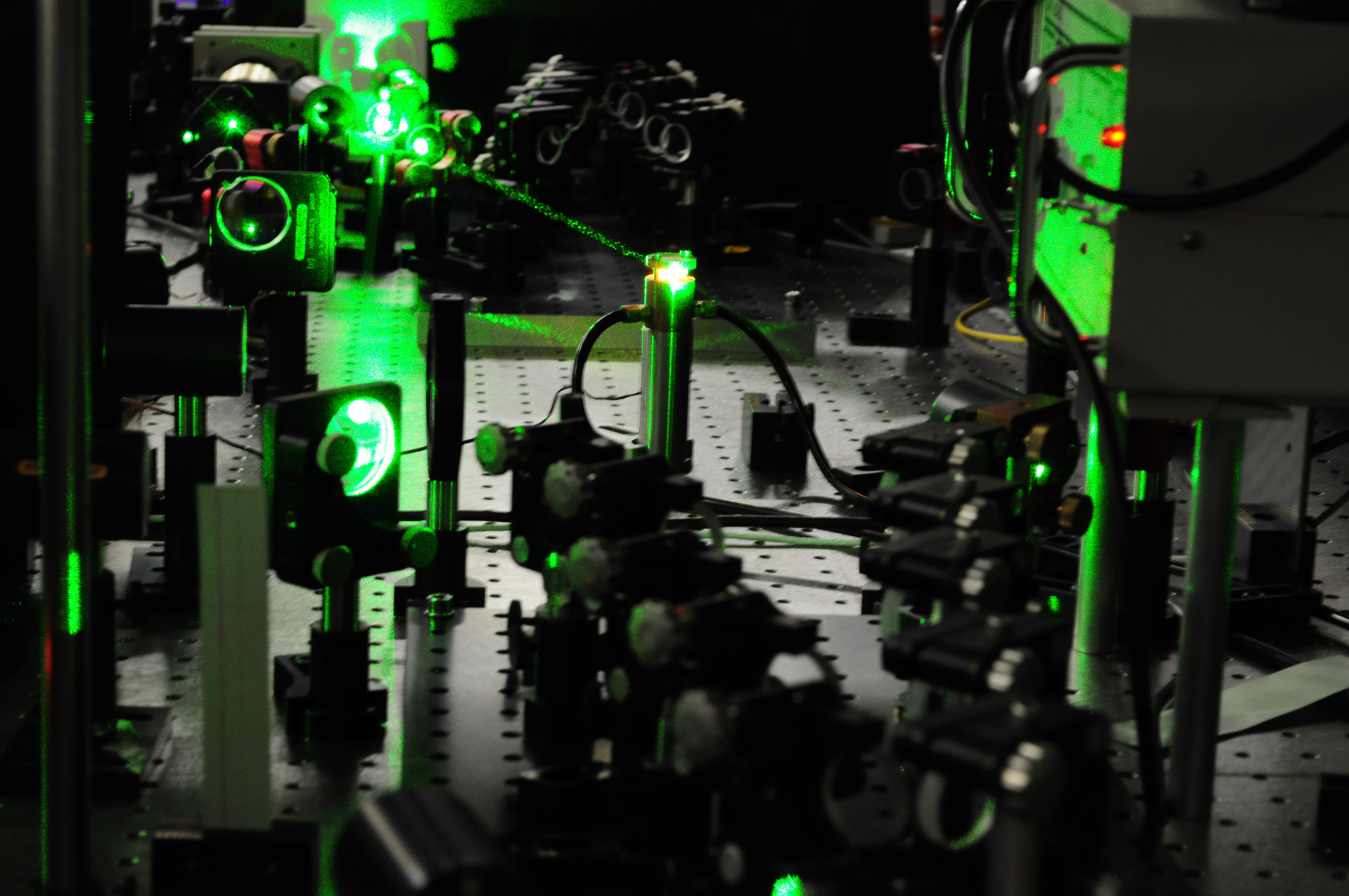
This work on the determination of the dissociation limit in molecular hydrogen was published in:
Later similar studies were performed for the D2 and HD isotopomers:
 Determination of ionization and dissociation energies of the deuterium molecule
Determination of ionization and dissociation energies of the deuterium molecule
 The ionization and dissociation energies of HD
The ionization and dissociation energies of HD
QED tests in the Hydrogen molecule: rotational sequence
In two-photon Doppler-free spectroscopic experiments on the EF-X system the sequence of rotational quantum states was investigated. Accurate level energies with repect to the v=0, J=0 ground state were determined. These level energies were compared with calculations of binding energies of the H2 molecule (including QED corrections). A comparison between experiment (published in: QED effects in molecules: Test on rotational quantum states of H2) and theory (work by Komasa, Pachucki and coworkers) was derived.
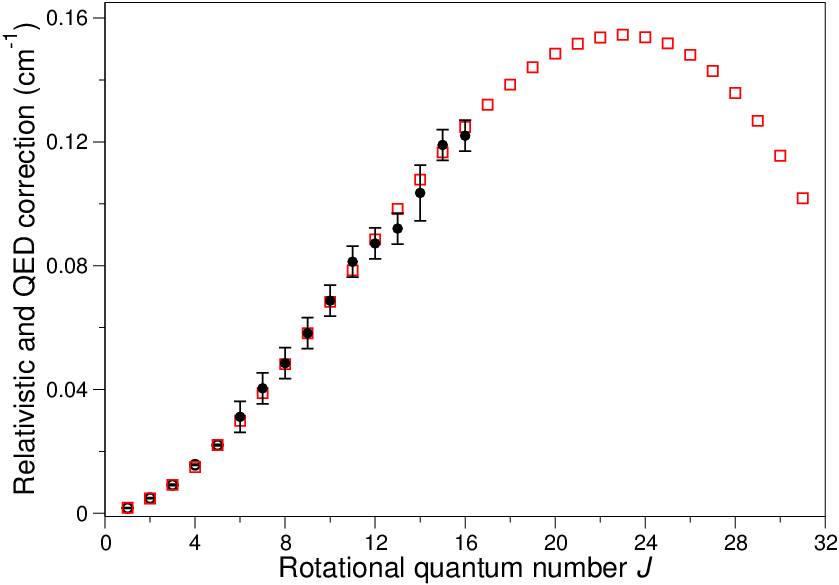
Comparison between experiment and calculation of QED effect
Test of Quantum Electro Dynamics in He and H2
The theory of Quantum Electro Dynamics (QED) represents the most fundamental description of all phenomena in electromagnetism. The theory goes beyond the description of Dirac in relativistic quantum mechanics as described by the Dirac equation. The theory is inspired from experiments that show devations from the Dirac description, most notable in experiments on the Lamb shift and the g-2 factor of the electron. For the first experimental determinations of these phenomena the Nobel Prize in physics (1955) was awarded to Willis Lamb and Polykarp Kusch. Later another typical QED phenomenon was predicted by the Dutch physicist Hendrik Casimir, later known as the Casimir effect.



Willis Lamb Polykarp Kusch Hendrik Casimir
Phenomena not accounted for in the Dirac formalism are the self-energy of the electron and vacuum polarization. For the theoretical description of QED the Nobel Prize (1965) was awarded to Sin-Itiro Tomonaga, Julian Schwinger, and Richard Feynman, who independently formulated the theory in rather different mathematical frameworks. Later Freeman Dyson showed that the theoretical descriptions were equivalent.




Sin-Itiro Tomonaga Julian Schwinger Richard Feynman Freeman Dyson
QED tests in the Helium atom
Currently the theory of Quantum Electro Dynamics is the most accurately tested theory in physics. While the Lamb shift was originally determined from the spectrum of the hydrogen atom, calculations of atomic QED-phenomena can also be tested in two-electron systems, like the helium atom. This gives also the opportunity to test two-electron contributions in QED. The status of atomic physics theory has evolved such that solution to the non-relativistic Schrodinger equation can be solved to 20-digit accuracy, even for the two-electron system He. Hence spectroscopic measurements present direct tests of relativistic and QED phenomena. The Lamb shift in helium is by far the largest in the ground state, where the effects of the sefl-energy of the electron and the vacuum polarization are strongest.
QED-effects in the helium atom
The QED-effects in the helium ground state were tested in a series of experiments, employed with a wavelength tunable extreme ultraviolet (XUV) laser source.
 A measurement with an XUV laser source based on fifth-harmonic generation of the doubled output of a commercial pulsed dye laser, delivering pulsed radiation at 58 nm to excite the 1s-2p transition in helium. A value of the Lam shift was determined with an accuracy of 1000 MHz. The work was published in Physical Review Letters: First laser excitation of the 4He 1 1S - 2 1P resonance line at 58 nm.
A measurement with an XUV laser source based on fifth-harmonic generation of the doubled output of a commercial pulsed dye laser, delivering pulsed radiation at 58 nm to excite the 1s-2p transition in helium. A value of the Lam shift was determined with an accuracy of 1000 MHz. The work was published in Physical Review Letters: First laser excitation of the 4He 1 1S - 2 1P resonance line at 58 nm. For the generation of XUV laser radiation the commercial PDL is replaces by a travelling-wave pulsed-dye amplifier (PDA), which is injection seeded by a continuous-wave ring dye laser. The experiment on the 1s-2p transition in helium and a derivation of the Lamb shift has an accuracy of 45 MHz. The work was published in Physical Review A: Lamb shift measurement in the 1 1S ground state of helium.
For the generation of XUV laser radiation the commercial PDL is replaces by a travelling-wave pulsed-dye amplifier (PDA), which is injection seeded by a continuous-wave ring dye laser. The experiment on the 1s-2p transition in helium and a derivation of the Lamb shift has an accuracy of 45 MHz. The work was published in Physical Review A: Lamb shift measurement in the 1 1S ground state of helium.

Resulting spectra obtained from XUV-PDL source (left) and XUV-PDA source (right)
 Later, almost two decades after the first experiments on the He Lamb shift, an XUV frequency comb laser system was developed in our Amsterdam team to excite the 1s-5p transition in helium at 51 nm. This led to a derivation of the Lamb shift at an accuracy of 6 MHz. The work was published in Physical Review Letters: XUV frequency comb metrology.
Later, almost two decades after the first experiments on the He Lamb shift, an XUV frequency comb laser system was developed in our Amsterdam team to excite the 1s-5p transition in helium at 51 nm. This led to a derivation of the Lamb shift at an accuracy of 6 MHz. The work was published in Physical Review Letters: XUV frequency comb metrology.QED tests in the Hydrogen molecule: measurement of dissociation energy
Quantum ab initio calculations have progressed since the original calculations by Heitler and London, that currently calculations of the Born-Oppenheimer energies, adiabatic and non-adiabatic corrections are so accurate that QED effects (including high-order relativistic effects) can be derived from spectroscopic measurements. One such experiment is the measurement of the dissociation energy of the Hydrogen molecule. In fact experimentally the Ionization Potential of H2 was determined in a three independent experiments bridging part of the energy separation between the molecular ground state and the extrapolation to the ground stae of the H2+ ion.

Left: 3 step excitation Right: relation between IP-limit and dissociation
For these studies a Titanium-Sapphire Oscillator amplifier laser system was used, built at LaserLaB.

This work on the determination of the dissociation limit in molecular hydrogen was published in:
Later similar studies were performed for the D2 and HD isotopomers:
 Determination of ionization and dissociation energies of the deuterium molecule
Determination of ionization and dissociation energies of the deuterium molecule The ionization and dissociation energies of HD
The ionization and dissociation energies of HD
QED tests in the Hydrogen molecule: rotational sequence
In two-photon Doppler-free spectroscopic experiments on the EF-X system the sequence of rotational quantum states was investigated. Accurate level energies with repect to the v=0, J=0 ground state were determined. These level energies were compared with calculations of binding energies of the H2 molecule (including QED corrections). A comparison between experiment (published in: QED effects in molecules: Test on rotational quantum states of H2) and theory (work by Komasa, Pachucki and coworkers) was derived.
Comparison between experiment and calculation of QED effect